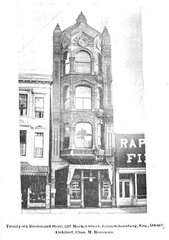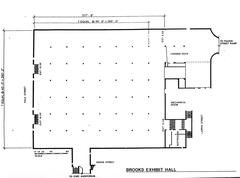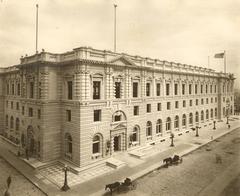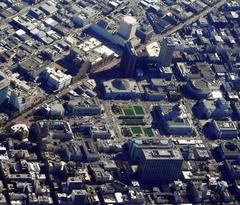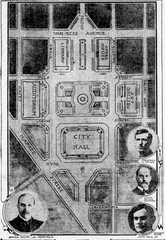
Civic Center San Francisco: Visiting Hours, Tickets, and Attractions Guide
Date: 14/06/2025
Introduction
Nestled in the vibrant heart of San Francisco, the Civic Center stands as a symbol of the city’s resilience, civic pride, and architectural grandeur. Conceived after the 1906 earthquake and fire, the Civic Center was inspired by the City Beautiful movement, which aimed to create monumental, harmonious public spaces that would foster community engagement and urban renewal. The district is anchored by landmarks such as San Francisco City Hall—with its iconic 307-foot dome—the Bill Graham Civic Auditorium, the War Memorial Opera House, and the Asian Art Museum (artandarchitecture-sf.com; gsa.gov; EAA Architecture).
The Civic Center has played a pivotal role in global events—hosting the 1945 United Nations Conference and the 1951 Treaty of San Francisco—and continues to serve as a dynamic venue for political activism, cultural festivals, and world-class performances (gsa.gov; civiccentersf.org; sfciviccenter.org). This comprehensive guide provides detailed information on Civic Center’s historical significance, key attractions, visiting hours, tickets, accessibility, transportation, safety, and insider tips to ensure a memorable visit.
Table of Contents
- Historical Overview and Architectural Significance
- Key Landmarks and Cultural Institutions
- Major Historical Events
- Visitor Information: Hours, Tickets, and Accessibility
- Getting There: Transportation and Parking
- Safety and Best Practices
- Events, Tours, and Amenities
- Dining, Shopping, and Lodging
- Photography and Visual Highlights
- Frequently Asked Questions (FAQ)
- Conclusion & Planning Resources
Historical Overview and Architectural Significance
Origins and City Beautiful Movement
The Civic Center’s origins date back to the early 20th century, following the devastation of the 1906 earthquake and fire. Urban planner Daniel Burnham’s 1905 vision emphasized a grand civic complex radiating from Market and Van Ness Avenues, inspired by the City Beautiful movement’s ideals of symmetry, monumental architecture, and integrated public spaces (artandarchitecture-sf.com). Although Burnham’s plan was only partially realized, it laid the foundation for Bernard Cahill’s subsequent master plan, which arranged monumental Beaux-Arts buildings around a central plaza (gsa.gov).
Architectural Landmarks
- San Francisco City Hall: Completed in 1915, City Hall is the Civic Center’s crown jewel. Designed by Arthur Brown Jr., its massive dome rises 307 feet, making it one of the tallest in the world. The Beaux-Arts style is evident in its grand staircases, Corinthian columns, and ornate interiors (artandarchitecture-sf.com).
- Bill Graham Civic Auditorium: Built for the 1915 Panama-Pacific International Exposition, this venue continues to host major public events and concerts.
- War Memorial Opera House and Veterans Building: Completed in 1932, these twin Beaux-Arts buildings are home to the San Francisco Opera and Ballet.
- Asian Art Museum: Housed in the former Main Library building, the museum is one of the largest in the Western world devoted to Asian art.
- Federal Office Building: Completed in 1936, this building was the final component of Cahill’s master plan.
The Civic Center’s layout—with buildings arranged symmetrically around Civic Center Plaza—creates a sense of order and grandeur. Its design and execution earned National Historic Landmark status in 1987 (Wikipedia: Civic Center, San Francisco).
Symbolism and Civic Identity
The Civic Center’s architecture symbolizes San Francisco’s aspirations for democracy, stability, and civic virtue. Open plazas and axial alignments foster civic engagement, with spaces designed for public gatherings, festivals, and demonstrations (EAA Architecture; Wikipedia: Civic Center, San Francisco; SF Civic Center Events).
Key Landmarks and Cultural Institutions
- City Hall: Free to enter, with guided tours available on weekdays.
- Asian Art Museum: Showcases over 18,000 works of art; admission tickets required.
- War Memorial Opera House: Home to the Opera and Ballet; ticketed performances.
- Bill Graham Civic Auditorium: Hosts concerts and public events.
- Louise M. Davies Symphony Hall: Venue for symphony concerts and educational programs.
- San Francisco Public Library (Main Branch): Modern facility with extensive collections and public programs.
- Orpheum Theatre and SFJAZZ Center: Popular for Broadway shows, jazz concerts, and cultural events.
- Civic Center Plaza and United Nations Plaza: Hosts public gatherings, markets, and major events.
Major Historical Events
- 1945 United Nations Conference: The War Memorial Veterans Building hosted delegates from 50 nations, leading to the drafting and signing of the UN Charter (gsa.gov).
- 1951 Treaty of San Francisco: Marked the formal end of WWII hostilities with Japan.
- Political and Social Movements: Civic Center Plaza has been the site of key protests, pride celebrations, and community festivals (civiccentersf.org).
Visitor Information: Hours, Tickets, and Accessibility
Visiting Hours
- San Francisco City Hall: Monday–Friday, 8:00 am–5:00 pm; guided tours weekdays at 10 am, noon, and 2 pm (reserve for groups of eight or more).
- Asian Art Museum: Tuesday–Sunday, 10:00 am–5:00 pm (extended hours Thursday to 8 pm).
- Bill Graham Civic Auditorium / War Memorial Opera House: Hours vary by event; check official websites.
- Other Venues: Check individual websites for specific hours.
Tickets and Admission
- City Hall and Civic Center Plaza: Free entry; tours are free but require advance booking for groups.
- Asian Art Museum: General admission $15; discounts for seniors, students, and youth (Asian Art Museum website).
- Opera House, Symphony Hall, Orpheum Theatre, and SFJAZZ Center: Tickets required for performances; purchase online or at box offices.
Accessibility
- Wheelchair ramps and accessible entrances at all major venues (sfplanning.org).
- BART and Muni Metro Civic Center/UN Plaza stations are fully accessible.
- Request accommodations (assistive listening devices, interpreters) 48 hours in advance via the Commission Secretary at 628.652.7589.
Getting There: Transportation and Parking
Public Transit
- BART/Muni Metro: Civic Center/UN Plaza station at Market & Eighth connects the entire Bay Area (sfciviccenter.org).
- Muni Bus Lines: 5, 21, 31, 47, 49, and the historic F streetcar.
- Plan your trip: 511.org
Parking
- Civic Center Garage (355 McAllister St.) and Performing Arts Garage (Grove & Franklin) are primary city-operated options.
- Accessible parking and elevator access available; private garages nearby.
Rideshare, Taxis, and Tour Buses
- Use 335 McAllister St. for rideshare pickups.
- Taxis and sightseeing buses regularly serve the district.
Safety and Best Practices
- Daytime: Civic Center is lively and generally safe.
- Nighttime: Use caution due to reduced foot traffic and visible homelessness (freedomforallamericans.org).
- Personal Safety: Keep valuables secure; car break-ins are less frequent but still possible (inside-guide-to-san-francisco-tourism.com).
- Stay Informed: Consult the SFPD crime map and Civic Center Community Benefit District dispatch at (415) 781-4700.
Events, Tours, and Amenities
Guided and Self-Guided Tours
- City Hall Public Tours: Weekdays, reservations required for groups.
- Civic Center Walking Tours: Free, led by City Guides volunteers; Tuesdays & Thursdays at 10 am.
- Self-Guided Tours: Download maps and guides from sfciviccenter.org.
Events
- Farmers Market: Heart of the City Market at UN Plaza, Wednesdays and Sundays.
- Major Festivals: San Francisco Pride Parade (June 28–29, 2025), concerts, fitness classes, and cultural celebrations (SFCivicCenter.org).
Visitor Services
- Visitor Information Center: 449 Powell St., 2nd Floor, or Hallidie Plaza (900 Market St.).
- Hours: Monday–Friday 9 am–5 pm; weekends 9 am–3 pm.
Dining, Shopping, and Lodging
- Dining: Civic Center and Hayes Valley offer farm-to-table restaurants, cafes, and markets (sftravel.com).
- Shopping: Hayes Valley features boutiques and local shops.
- Lodging: Options near Civic Center include Inn at the Opera (333 Fulton St.) and Phoenix Hotel (601 Eddy St.) (sftourismtips.com).
Photography and Visual Highlights
Capture the grandeur of City Hall’s dome, Civic Center Plaza events, and vibrant scenes at the Heart of the City Farmers Market. Visit during golden hour for the best lighting. Explore virtual tours and interactive maps on official websites for a digital preview.
Frequently Asked Questions (FAQ)
Q: What are the Civic Center visiting hours?
A: Most venues like City Hall are open Monday–Friday, 8 am–5 pm. Museums and theaters have varied hours; check official sites.
Q: Do I need tickets to visit City Hall or museums?
A: City Hall is free to visit; tours require reservations for groups. Museums such as the Asian Art Museum require tickets.
Q: Is Civic Center safe for visitors?
A: Civic Center is safe by day. At night, use caution and consider rideshare or taxis.
Q: Are Civic Center venues accessible?
A: Yes, all major venues and transit stations offer accessibility features.
Q: Where can I find guided tours?
A: City Hall and City Guides offer public and walking tours; self-guided tours are available online.
Conclusion: Plan Your Visit to Civic Center San Francisco
San Francisco’s Civic Center blends historical grandeur with vibrant contemporary culture. Whether you’re exploring its monumental architecture, attending world-class performances, or participating in civic events, the district offers an enriching experience for all. Plan your visit by checking current hours, booking tickets in advance, and using public transportation for convenience. Explore guided tours, seasonal festivals, and local dining to make the most of your trip.
For more travel tips and event updates, download the Audiala app and follow us on social media. Enhance your Civic Center adventure and discover why this district remains a cornerstone of San Francisco’s identity.
References and Useful Links
- San Francisco Civic Center: Visiting Hours, Tickets, and Historical Significance
- San Francisco Civic Center Historic District Monograph, US General Services Administration
- Architecture Behind San Francisco City Hall, EAA Architecture
- Civic Center, San Francisco, Wikipedia
- San Francisco Civic Center Visitor Guide, SF Civic Center Organization
- San Francisco Government: Perfect Day Around Civic Center
- San Francisco Civic Center Stories, Civic Center Community Benefit District
